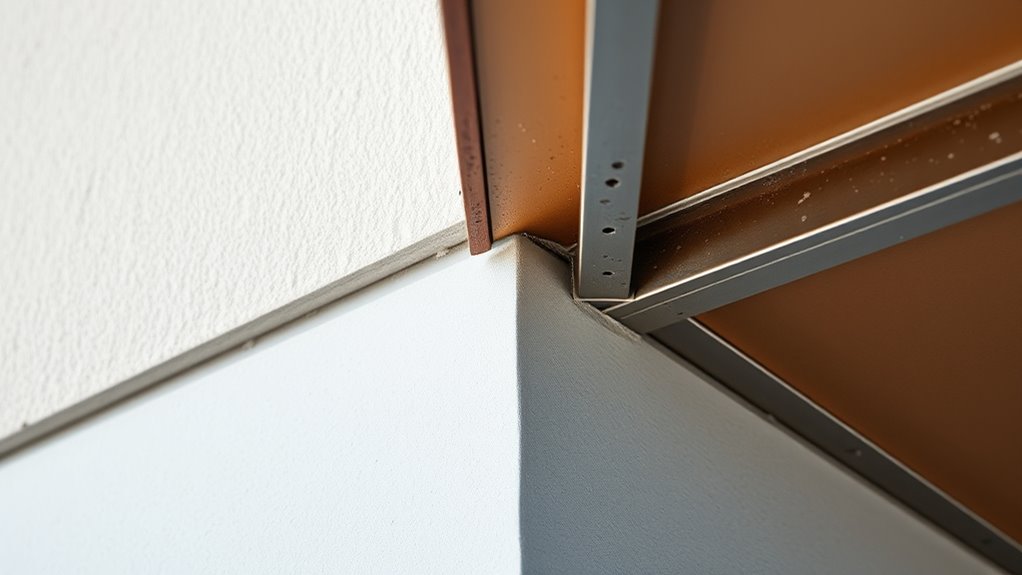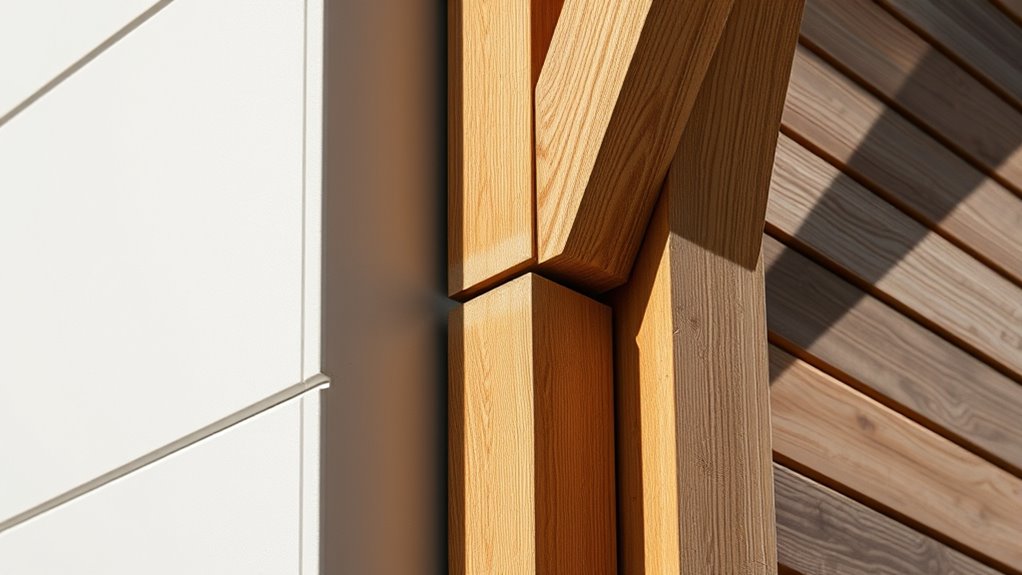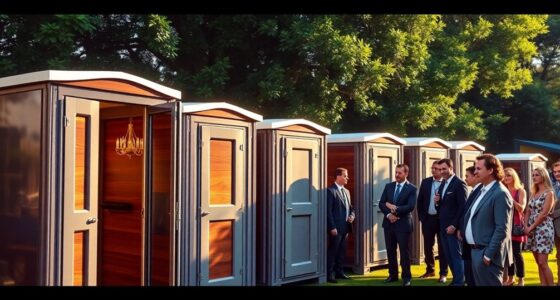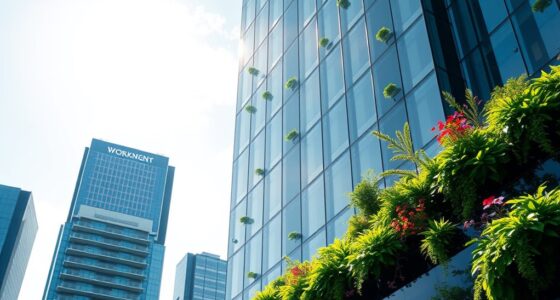Thermal bridging happens when building materials create unintended pathways that let heat bypass insulation, causing cold spots and higher energy costs. You can avoid it by ensuring continuous insulation, sealing gaps, and using non-conductive materials like thermal breaks at junctions. Proper installation and regular inspections are key to maintaining a seamless barrier. Want to learn how to identify and prevent thermal bridging effectively? Keep exploring for practical solutions that boost your building’s energy efficiency.
Key Takeaways
- Thermal bridging occurs when heat bypasses insulation through conductive materials like metal or concrete.
- It causes uneven temperatures, drafts, and cold spots near windows or walls.
- Prevent by ensuring continuous insulation and proper sealing at junctions and openings.
- Use thermal breaks—non-conductive materials—to interrupt heat transfer paths.
- Regular inspection and maintenance help identify and repair gaps or deterioration over time.

Have you ever noticed how certain parts of a building feel colder or warmer than others? That sensation often points to issues with thermal bridging, which occurs when heat bypasses the insulation and travels through more conductive materials. You might feel a chill near a window frame or a drafty spot along an exterior wall, and that’s usually because of gaps in insulation or breaks in the structural continuity. These gaps or discontinuities allow heat to escape in winter or enter during summer, making your indoor environment less comfortable and less energy-efficient.
Thermal bridging happens when materials like metal, concrete, or wood act as pathways for heat transfer. If your building’s design isn’t careful about maintaining continuous insulation, these pathways become more pronounced. Insulation gaps, whether caused by poor installation, settling, or design flaws, create weak spots where heat can easily flow through. Instead of being evenly distributed, heat leaks out at these points, reducing the overall effectiveness of your insulation system. Structural continuity is essential here—you want your insulation to form a seamless barrier across all parts of the building envelope. When continuity is broken, it’s like having tiny holes that undermine your efforts to keep the indoor temperature stable.
Thermal bridging occurs when building materials create pathways that compromise insulation effectiveness.
To avoid these issues, you need to pay close attention during construction or renovation. Ensuring continuous insulation from the foundation to the roof minimizes the chances of gaps or breaks. Proper installation techniques, such as using continuous insulation boards or carefully sealing joints, are vital. Be aware of common weak spots—around window and door openings, where framing interrupts the insulation layer, or at junctions between different building elements. Sealing these areas with high-quality, durable materials helps maintain structural continuity and prevents insulation gaps from forming.
Another way to combat thermal bridging is to incorporate thermal breaks—non-conductive materials placed between conductive components. These breaks interrupt the heat flow and considerably reduce the risk of thermal bridging. Additionally, regular inspections and maintenance can catch any deterioration or gaps that might develop over time, ensuring your building remains well-insulated. Proper design and construction practices that prioritize structural continuity are crucial for minimizing heat transfer pathways. Remember, the goal isn’t just to fill space with insulation but to create a continuous, airtight barrier that keeps heat where it belongs—inside during winter and outside during summer.
Frequently Asked Questions
How Does Thermal Bridging Affect Energy Bills Long-Term?
Thermal bridging increases your energy bills long-term by reducing your home’s energy efficiency and compromising insulation performance. When heat escapes through these gaps, your heating and cooling systems work harder, consuming more energy. This not only raises your bills but also strains your system, leading to potential repairs. To save money, you should minimize thermal bridging by improving insulation and sealing weak spots, ensuring your home stays warm or cool efficiently.
Are Certain Building Materials Less Prone to Thermal Bridging?
Think of building materials as armor for your home’s energy efficiency. You’ll find that materials like insulated concrete forms or structural insulated panels are less prone to thermal bridging, making them excellent choices. These materials enhance insulation effectiveness by reducing heat transfer through the building envelope. When selecting building materials, prioritize those that minimize thermal bridging, saving you money on energy bills while keeping your home comfortable year-round.
Can Thermal Bridging Occur in All Climate Zones?
Yes, thermal bridging can occur in all climate zones. You should use effective insulation strategies and proper construction techniques to prevent it. In colder climates, it’s especially important to minimize heat loss through these bridges, while in warmer zones, they can lead to increased cooling loads. Regardless of your location, make certain your building design incorporates continuous insulation and thoughtful framing to reduce thermal bridging and improve energy efficiency.
What Are the Latest Technologies to Prevent Thermal Bridging?
Your home’s energy efficiency depends on staying ahead of thermal bridging, and the latest tech makes that possible! Modern insulation techniques like continuous exterior insulation, thermal breaks, and advanced framing drastically reduce thermal bridging. These innovations strengthen your building envelope, ensuring no heat escapes or enters through unwanted pathways. By adopting these cutting-edge solutions, you’ll transform your home into an energy-saving fortress, keeping comfort high and costs low.
How Do Thermal Bridges Impact Indoor Air Quality?
Thermal bridges can negatively impact your indoor air quality by creating cold spots that promote condensation and mold growth. This affects indoor humidity levels, making the air feel damp or musty. Poor air circulation around these areas worsens the problem, trapping pollutants and allergens. To maintain healthy indoor air, you should improve insulation and guarantee proper ventilation, reducing the risks associated with thermal bridging and enhancing overall air quality.
Conclusion
Understanding thermal bridging is like recognizing the quiet flaws behind a beautiful wall—you might not see them at first, but they weaken the whole structure. By avoiding these hidden gaps, you protect your home from energy loss and comfort issues. Think of it as sealing the cracks in a fortress; it’s the difference between a strong, insulated space and one vulnerable to the elements. Don’t overlook these details—secure your home’s efficiency and longevity today.










